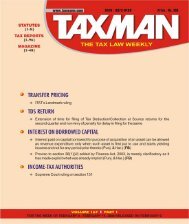news round up - Taxmann
news round up - Taxmann
news round up - Taxmann
- TAGS
- news
- round
- taxmann
- taxmann.com
You also want an ePaper? Increase the reach of your titles
YUMPU automatically turns print PDFs into web optimized ePapers that Google loves.
130 GOODS & SERVICES TAX - MAGAZINE [Vol. 1<br />
subsequently, paved way for a more sound and comprehensive GST<br />
regime, expected to come into operation from April 1, 2010.<br />
GST - A broad-based single comprehensive tax<br />
2. The idea of GST is basically to create a broad-based and single<br />
comprehensive tax leviable on goods and services provided and/or consumed<br />
in an economy. In simple terms, it may be defined as a tax on goods<br />
and services which is leviable at each point of sale or rendering of service,<br />
in which at the time of sale of goods or rendering of services, the seller or<br />
service provider, may claim the input credit of tax which he has paid while<br />
purchasing the goods or procuring the services. The GST regime has<br />
already been implemented by more than 150 nations worldwide (comprising<br />
of both developing as well as developed economies) and has been well<br />
received across various Governments as well as the industry/trade,<br />
thereby resulting in major revenue augmentation, and simultaneous<br />
increase in credibility, transparency and efficiency, etc., in their respective<br />
tax systems. Traditionally speaking, until now all of the Central levies come<br />
into play only at the manufacturing level and do not extend below it. But,<br />
in accordance to the proposed model of GST in India1 , it is pitted to capture<br />
the value-added chain in the distribution trade below the manufacturing<br />
chain as well, while simultaneously also extending the scope of the State<br />
levy which is presently restricted to sale/purchase of goods, by enlarging<br />
its scope of taxation by allowing taxation at the manufacturing level as<br />
well as rendering of services. With this primary objective in mind, it is<br />
important now to discuss the proposed model of GST.<br />
3. GST Model in India<br />
(i) Taxes to be subsumed under the GST - GST is implemented across the<br />
globe in various models tailored to suit the specific requirements<br />
with respect to the individual fiscal policy of nation States. In India,<br />
considering the current federal set-<strong>up</strong> where there exists distribution<br />
of taxing powers between the Centre and the States, administered<br />
through appropriate legislations, it is more suitable to develop<br />
and adopt a dual system of GST. The design of the proposed GST<br />
scheme ideally should have been in such a way that, both the Central<br />
GST (or CGST) and State GST (or SGST) operates in a parallel<br />
fashion, thereby removing the existing distinction between the goods<br />
and services leading to subsuming of a number of Central as well as<br />
State levies into a consolidated levy. This particular aspect has been<br />
well considered and has also received due attention in the said paper,<br />
wherein it is being prescribed that, the taxes or levies to be subsumed<br />
1. First discussion paper on Goods and Services Tax in India, November 10, 2009.<br />
GOODS & SERVICES TAX CASES ❑ JANUARY 20 - FEBRUARY 4, 2010 ◆ 40











![“FORM NO. 3CEB [See rule 10E] Report from an ... - Taxmann](https://img.yumpu.com/45480232/1/190x245/form-no-3ceb-see-rule-10e-report-from-an-taxmann.jpg?quality=85)





